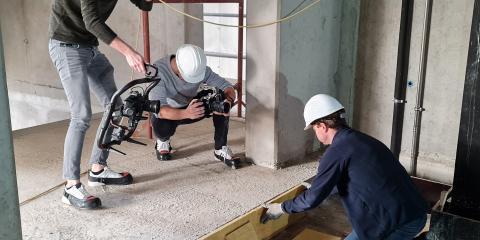Main page content
Entity view (Content)
Theater aan de Parade

Entity view (Content)
Premium acoustics are a quintessential part of any modern-day theater or performance space. Noise coming in from other rooms or even from outside can disturb live performances. High-performance acoustic floating floors such as our raiseable Stravifloor Jackup-R system are ideal for the acoustic treatment of such sound sensitive venues.
In 's-Hertogenbosch, the Netherlands, construction of the new performing arts theater is well underway. Planned to open in the second half of 2023, 'Theater aan de Parade' will house 2 multifunctional halls, each with its own atmosphere and programming. The new glass façade will shower the interior with natural light and invite people in.
In collaboration with our local partner Delta-L and with Mertens Bouwbedrijf, the general contractor involved, we paid the installation team a visit while they were installing the Stravifloor Jackup-R floating floor system.
Tim Rutjes
Delta-L
"Special in this project was that rather high-concentrated loads were applied to the floating floor. That was also the added value of this system, because we could first pour the floating concrete floor and only later introduce the springs underneath the slab. The advantage is that you can first achieve a homogeneous floor thickness and only later apply the load to the floor."
How big was the area treated?
The total area was 543 m², divided over 3 zones. We used 272 boxes, which equates to a centre-to-centre distance of about 1.4 to 2 m. 40 mm of mineral wool was placed in the air cavity to counteract so-called standing waves. This ensures good sound insulation even at higher frequencies.
Can you describe some of the peculiarities of this project?
Special in this project was that rather high-concentrated loads were applied to the floating floor. That was also the added value of this system, because we could first pour the floating concrete floor and only later introduce the springs underneath the slab. The advantage is that you can first achieve a homogeneous floor thickness and only later apply the load to the floor.
Locally, several springs are needed to support the high point loads applied to the floating concrete floor. In a traditional floating floor system, where the concrete floor is poured directly on top of the springs, we see that these stiffer springs hardly deflect, resulting in a non-homogeneous floating floor thickness. When afterwards adding point loads it will be difficult to control the deflection properly.
Different types of springs were used. There are two types in terms of stiffness. In total, three different configurations were made with these. This, to match the springs in the right way when it comes to the deflection and thus the performance of the floating floor.
Bram Veelhaver
CDM Stravitec
"The challenge with this floor was in bearing a certain variable load on top of the floating floor, a load that is considerably high if I might say so. There is no formwork panel on top of the isolators. This is because the isolators are incorporated in the floating floor."
In consultation with the client, the acoustician and our partner Delta-L in the Netherlands, we designed this floor, according to the client's requirements.
What makes this type of floating floor different from other systems?
There is no formwork panel on top of the isolators. This is because the isolators are incorporated in the floating floor. As a result, you also don't have to take into account the bending stiffness of those lost formwork panels. Of course, you have to consider the thickness of the floor and the type of reinforcement used in the floor. The insulators in the Stravifloor Jackup-R boxes are inspectable and replaceable at all times, both springs and elastomers.
Delta-L takes care of the complete installation of the floating floor and can of course call on CDM Stravitec's expertise and support at all times.
We chose the jack-up floating floor from CDM Stravitec to build a complete box-in-box construction, so that this room is completely acoustically interrupted from the rest of the building. When they are playing music in this part of the building, the rest of the building will be totally quiet.
Mark van Diepen
Mertens Bouwbedrijf B.V.